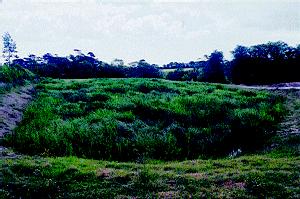| 2002 |

|
YEAR BOOK |
TEAGASC - JOHNSTOWN CASTLE, UNIVERSITY COLLEGE DUBLIN & D�CHAS, THE HERITAGE SERVICE
|
A wetland approach!
|

Another method of managing FYDW or other nuisance waters generated on the farm includes constructed wetlands. Wetlands provide many functions and values and one of these is the inherent ability to clean incoming waters through a range of biological, chemical and physical processes that exist within the wetland environment. Through research and operation for over forty years, wetland science and technology is now a well-accepted technology. Wetlands have been used to treat many different types of wastewaters � including agricultural, municipal, industrial � along with storm water runoff and acid mine drainage.
Teagasc at Johnstown Castle Research Centre is involved with monitoring the performance of a D�chas initiated constructed wet-land design to treat FYDW. The D�chas design � called integrated constructed wetlands (ICWs) � incorporates water quality management, habitat creation and landscape fit, to provide an integrated and resource management approach to the control of such wastewaters.
Under the Teagasc Walsh fellowship scheme, a three-year research programme is being undertaken. The main objectives of the research programme are to continue monitoring of the ICW along with understanding some of the processes involved in the retention of phosphorous (P) within wetland environments.
Contact: Ed Dunne, Teagasc Johnstown Castle, Wexford;
E-mail: [email protected] ;
Dr Noel Culleton, Teagasc Johnstown Castle, Wexford; Tel: 053-42888;
Dr Grace O�Donovan, Department of Environmental Resource Management, UCD;
E-mail: [email protected] ;
Dr Rory Harrington, D�chas, The Quay, Waterford; Tel: 051-854329.